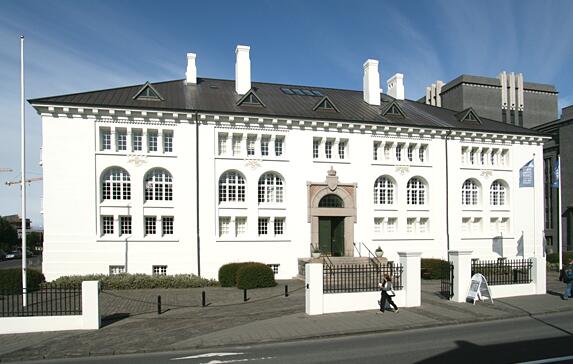1830-1920
Only around 1830 can one speak of actual rebirth in Icelandic literature. The new era is ushered in by the journal Fjölnir, published from 1835, with the aim of purifying the language, enhancing the literature and awakening the national feeling of the people. Jónas Hallgrímsson’s monumental poem Iceland in the first year of the journal depicts the present decay on the basis of the glorious antiquity, and expresses the direction program. Jónas Hallgrímsson was a sharp critic of the popular Roman poetry, which was still fully alive in the 19th century. Its foremost representative was Sigurður Breiðfjörður (1798-1846).
A master of another traditional popular poetry form, the satirical small poem, was the farmer Hjalmar Jónsson (Bólu-HELmar, 1796-1875). At the academic level, the legacy of Jónas Hallgrímsson is passed on by Jón Thoroddsen (1818–68), while the diplomat Grímur Thomsen (1820–96) lived in the international spirit world while cultivating domestic traditions. The most rugged figure in Icelandic lyric in the second half of the 19th century was the priest Matthías Jochumsson (1835–1920). Christianity and the national were his main sources of inspiration. But in his time, Icelandic literature also gained lyricists who joined more modern spiritual movements, such as the radicals Þorsteinn Erlingsson and Stephan G. Stephansson. Other significant lyricists at the turn of the 20th century are Einar Benediktsson (1864-1940), Steingrímur Thorsteinsson and politician Hannes Hafstein (1861-1922).
Icelandic prose poetry, which became extinct with saga writing, was resurrected in the 19th century. After the middle of the century, Icelandic fairy tales and folk traditions were gathered, first and foremost by librarian Jón Árnason (1819–88) and the priest Magnús Grímsson (1825–60). Realism had its breakthrough in Icelandic literature with the novelist Gestur Pálsson. The same spirit also belonged to the skilled prose stylist Jón Stefánsson (Þorgils gjallandi). Excellent life painters are Guðmundur Magnússon (Jón Trausti) and the somewhat younger Guðmundur Friðjónsson.
After 1920
Around 1920, a renewal of Icelandic lyricism takes place, a displacement of the nature-descriptive and patriotic in favor of internalization and subjectivity, first by the Norwegian-influenced Stefán frá Hvítadal (1887–1933). The most famous lyricists of the following period are Davíð Stefánsson, Jóhannes frá Kötlum, Tómas Guðmundsson and Steinn Steinarr. However, a modernist breakthrough occurred only in the 1950s, with a group of younger writers and other artists gathering around the avant-garde magazine Birtingur. Key names among the first modernist lyricists are Einar Bragi, Stefán Hörður Grímsson,Jón Óskar, Hannes Sigfússon and Sigfús Daðason. At the forefront of the true modernist breakthrough is Jón ur Vör, who published the first collection of free verses in Icelandic. Regardless of school curricula and group formation, the fine modernists Snorri Hjartarson and Ólafur Jóhann Sigurðsson also stood.
The dominant name in Icelandic literature in the 20th century is Halldór Kiljan Laxness, who with his novels has created some of the finest in modern European prose art. Laxness’s authorship, which culminates in public life portrayals such as Salka Valka and Self-Employed People and historical novels such as the Iceland Clock, was rewarded with the Nobel Prize in Literature in 1955. Prior to Laxness’s most important novels, Þórbergur Þórdarson’s radical confessions, Bréf came to Láru (1924). its highly subjective form gained importance for both Laxness and other writers of the interwar period. Initially, some of the important names in the prose literature of the period wrote in other Nordic languages. Gunnar Gunnarsson (in Danish) and Kristmann Guðmundsson (Norwegian).
Icelandic literature in the 20th century and later is part of world literature and is closely related to it. But the national traditions have great power, and the modern-day rhyming verses have shocked many readers in a country where traditional forms such as fixed rhythm and end rhyme, and especially literal trim, have claimed a thousand years.
The circle of modernism around the journal Birtingur from the 1950s also includes the influential prose writer Thor Vilhjálmsson. He is an experimental writer whose action is often subordinate to the chaotic sense of life itself, his lyrically embossed prose art reflects the loneliness and divisiveness of modern man. He received the Nordic Council Literature Prize in 1988 for the novel Grámosinn glóir (Gråmosen göder). Other important prose writers from the same generation are Svava Jakobsdóttir and Guðbergur Bergsson.
The Nordic Council Literature Prize 1995 was awarded to one of the foremost representatives of the younger author generation, Einar Már Guðmundsson. But writers like Pétur Gunnarsson, Steinunn Sigurðardóttir, Sigurður Pálsson, Einar Kárason and Thorarinn Eldjarn, all writes both prose and poetry, makes itself also strong in the current Icelandic literature. Recently Ólafur Gunnarsson has also had success with his epic novels.
Female writers have gained an increasingly strong position in Icelandic literature. Among them are lyricists such as Vilborg Dagbjartsdóttir, Nína Björk Árnadóttir (also prose) and Íngibjörg Haraldsdóttir. Central female prose writers are Frida Á. Sigurðardóttir (Nordic Council Literature Prize 1992), Alfrún Gunnlaugsdóttir, Vigdís Grímsdóttir and Thorunn Valdimarsdóttir.
In the lyrics , the older generation and the middle generation dominate. Important names are Hannes Pétursson, Matthías Johannessen, Thorsteinn from Hamri and Jóhannhillmarsson. However, the younger generation of poets has a prominent representative in Gyrðir Elíasson, who has characterized himself as a lyricist and proseist. Another fine prosaist is Jón Kalman Stefánsson. – Both in the latter two and in several of today’s leading younger writers, we are again confronted with the individual, its life-anxiety and the exploration of meaning with existence. Others of the younger ones, e.g. Hallgrímur Helgason and Mikael Torfason, writes cruder texts where both postmodernism’s dissolution of traditional values and the media society’s confused understanding of reality lie behind languages and narratives. Elements from both directions can be found at Didda (pseudonym for Sigurlaug Jónsdóttir), who also writes lyrics for punk bands.
One genre that has only been seriously cultivated in Iceland in recent years is the crime novel. However, after Arnaldur Indriðason debuted in the late 1990s, the Icelandic writer’s figure also includes one of the Nordic region’s foremost suspense writers.
At the Safnahúsið in Reykjavík, selected medieval manuscripts are shown to the public.
